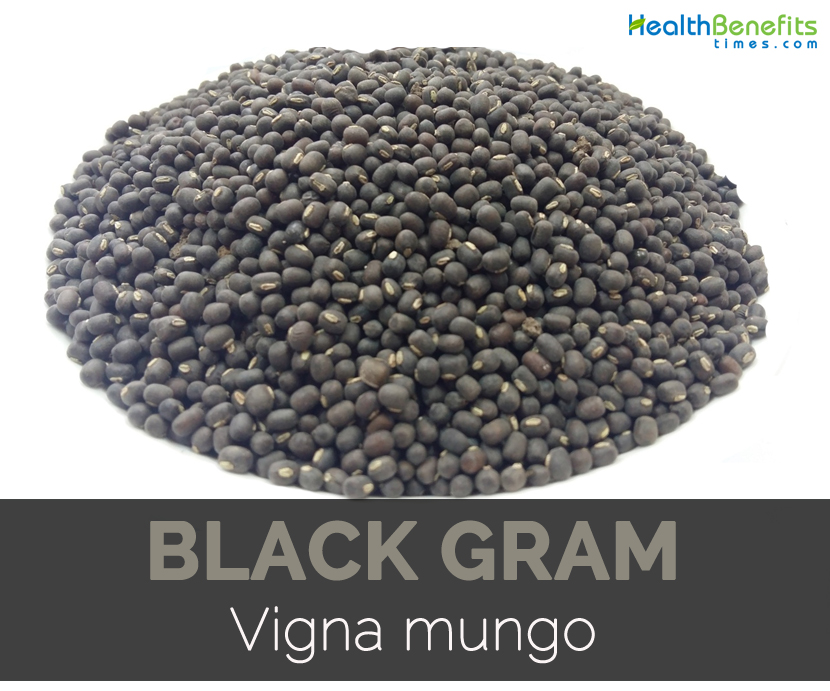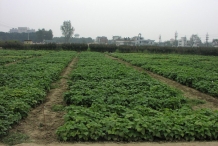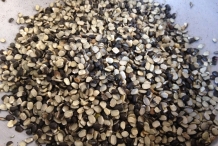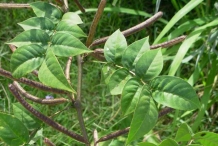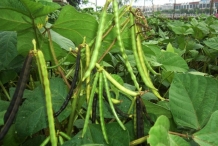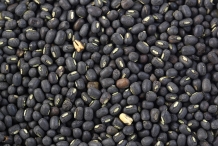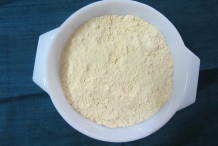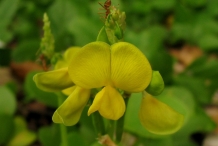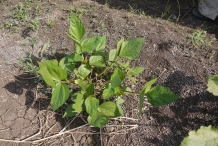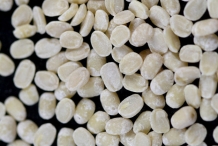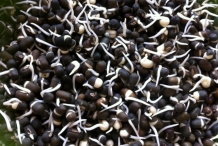| Black gram Quick Facts |
| Name: |
Black gram |
| Scientific Name: |
Vigna mungo |
| Origin |
Vigna mungo |
| Colors |
Black or grey black or mottled |
| Shapes |
Ovoid to rounded |
| Calories |
706 Kcal./cup |
| Major nutrients |
Copper (225.67%)
Iron (195.88%)
Isoleucine (159.33%)
Valine (138.78%)
Manganese (137.43%)
|
| Health benefits |
Digestive health, Heart health, Treatment for diabetes, Relieve inflammation, Bone health |
Black gram with other names as urad bean, black gram, mungo bean, minapa pappu and black matpe bean, is a bean which is widely grown in Indian subcontinent. It is also considered to belong the same species of mung bean. The whole urad bean is sold as black lentil and split bean is known as white lentil. Black gram is originated in India and has been cultivated since ancient times and is one of the pulses which is highly prized in Pakistan and India. Black gram is also introduced to other tropical areas such as Fiji, Caribbean, Africa and Mauritius.
It is the nutritious pulse crops which are commonly known as urdbean. Seeds have high content of carbohydrates, protein, minerals, fat, vitamins, potassium, niacin, calcium, iron, riboflavin and thiamine and amino acids. It has short period pulse crop and is self-pollinated. The harvest is low in comparison to other grain legumes. Black gram accompanies essential amino acids which is provided in most cereals and has a vital role in diets of India and Nepal. It is widely known for making dal. Black gram is an imperative part of exotic cuisines such as stews, soups, curries, bread and side dishes.
Black gram is clinically referred to as Phasiolus mungo and it’s also popularly known as Urad in India. India is its primary origin and is also primarily grown in Asian countries which includes Pakistan, Myanmar and parts of southern Asia. About 70% of world’s black gram production originates from India. An essential component in Indian cuisine, Vigna mungo or even the black gram (often called urad dal in India) is a kind of lentil which is mainly grown within the southern parts of Asia. It is just a hugely nutritious bean that is packed with remarkable health benefitting qualities. Due to its therapeutic as well as healing qualities, Black gram is essentially utilized in Ayurvedic medication. Black gram can be purchased in the whole form with its skin on, split form with its skin on or even split form without its skin. Soaking this particular lentil just before cooking will accelerate the cooking time. Additionally it is locally referred to as Udad dal, Uzhunu (Malayalam), Minumulu (Telegu), Adad dal (Gujarati), Biri dali (oriya), Uddina bele (kanada), urdu bele (Tulu), Ulunthu, Uluttham Paruppu (Tamil), while maash (Nepali), d?u mu?ng an (Vietnamese).
History
Black gram is originated in India where it was cultivated from ancient times. Black gram was introduced by Indian immigrants to other topical areas.
Plant
Vigna mungo is densely hairy, erect, suberect or trailing and annual herb with taproot producing branched root system having smooth and rounded nodules. The plant grows 30 to 100 cm. Leaves are trifoliolate having 3 ovate or rhombic ovate leaflets and measures 4 to 10 cm by 2.5 to 5 cm. Flowers are small, axillary and bright yellow in color. Fruit is a cylindrical and upright legume pods. Pods are cylindrical, narrow measuring 4 to 6 cm long. Each pod possess 4 to 10 seeds in ellipsoid shape and usually black or mottled or grey black in color.
Health benefits of Black gram
Black gram is used as a staple food in India and other parts of subcontinent for many years. Probably the most well-known and high nutritional beans is Black Gram.This particular gram belongs to bean family, just like the mung beans species. This really is typically referred to as Urad Dal that is consumed by human beings in nearly every corner of the nation just as one essential part of their daily meal. Urad dal is healthier compared to almost every other beans available for sale. It may be consumed daily since it has numerous incredible qualities that are great for health. Besides its taste, it contains wide range of nutrients which has positive impact on health in various ways. Here are some wonderful health benefits of consuming black gram:
- Digestive health
Consumption of Black gram helps to treat health conditions such as constipation, bloating and indigestion. Black gram has high content of fiber. Fiber is essential to maintain digestive health. It adds bulk to stools which assist passage of waste through intestinal tract. The people with constipation should increase an intake of fiber to see positive difference. It lowers symptoms of constipation, bloating, diarrhea and cramping. The evidence shows that intake of fiber rich food decreases the chances of diabetes, heart disease and colon cancer.
- Heart health
Consume black gram and foods rich in fiber to ensure heart health. Evidence shows that foods rich in fiber such as black gram lower the level of blood cholesterol. High level of cholesterol is the major risk factor in heart attack, stroke and atherosclerosis. Besides lowering cholesterol, it contains several nutrients which are beneficial for heart health. Potassium lowers blood pressure as it acts as vasodilator that soothes passage of blood through blood vessels which puts less strain on heart. It contains folate which is associated with lower risk of heart disease. It contains adequate amounts of magnesium and iron which promotes blood circulation in the body.
- Treatment for diabetes
Black gram is rich in fiber which is beneficial to maintain blood sugar levels in check which helps to lower the person becoming diabetic and keeps the symptoms in check. Fiber helps to regulate the absorption of nutrients which maintains balance in glucose and sugar amount in blood. The meal prepared with black gram assist in prevention of harmful spikes in blood glucose which is commonly experienced by diabetic patients.
- Relieve inflammation
Black gram is used in Ayurvedic medicine as it is able to sooth inflammation and provides relief from pain. Black gram contains wide range of nutrients which eases internal inflammation and also lowers oxidative stress in body. Black gram assist internal inflammatory conditions and extract prepared with black gram is applied topically for dealing painful muscles and joints. Apply it to aching joints to get faster relief. Boil black gram with rock salt and sesame oil for making decoction and apply it to affected areas to lower inflammation and pain caused due to arthritis and joint pain.
- Bone health
Black gram has minerals such as calcium which is beneficial for bone health. Calcium is essential for growth and development due to these young children is given milk from childhood years. Calcium is essential as the person ages. As the person ages, we lose bone mineral density which results in weak bones and makes more prone to injury. Adequate amount of calcium and minerals such as magnesium and potassium is essential to make the bones strong and lowers the chances of health conditions such as osteoporosis.
- Increase energy
High content of protein and adequate amount of iron is present in these beans which promotes level of energy and lowers fatigue. Iron is a crucial mineral for vitality. The deficiency of iron causes mental as well as physical tiredness and fatigue. It also eliminates serious conditions such as anemia and symptoms such as chronic fatigue, muscle weakness and cognitive impairment.
- Skin health
Black gram in powdered form is used in India to keep the skin look fresh and make it supple. It as nourishing properties which assist to rejuvenate tired and sallow looking skin. It is useful for treating skin problems such as age spots, sun damage, acne and wrinkles. It is used for exfoliating skin and when combined with lemon juice, it makes natural bleach which could lighten skin. It is used in Ayurvedic remedies in form of pastes and decoctions for every skin condition. It also soothes pain of sunburns, lower symptoms of acne and intensity of tan.
- Nervous problems
Black gram is helpful for dealing nervous associated problems such as hysteria, nervous weakness memory weakness and schizophrenia. Though the consumption of black gram could not treat these conditions completely, it could provide relief from these problems. Being a great source of minerals and vitamins, it is helpful to maintain good health and also refresh the mind.
- Build muscles
Black gram is helpful for those who want to improve muscle health. Being a rich source of protein, it is an ideal choice for developing and strengthening whole body by stimulating muscle tissue build. Both men and women are advised to consume black gram daily for improving muscles and keep it stronger and attractive.
- Treatment for dandruff
Black gram supports hair care and is useful for treating dry, frizzy hair. Use black gram for managing dry brittle hair as it has high content of fatty acids and minerals which helps to revive hair luster. It also conditions hair and makes it look shiny. In order to treat dandruff, use black gram paste by mixing green gram paste and apply it to hair. This helps to eliminate dandruff and also strengthen, clean and soften hair.
11. Good for pregnant women
Pregnant women are frequently recommended to include black gram within their diet due to its higher nutritional value. Black gram is really a rich source of iron, that is required for the creation of hemoglobin and increased blood flow. Additionally it is full of protein, dietary fiber as well as nutrition just like folic acid which is not only great for the expecting mother but in addition for the fetus since it works well for avoiding birth defects.
https://www.youtube.com/watch?v=Hl_TfQYoZSw
Recipe of Black Gram
1. Black Gram Flour Cake
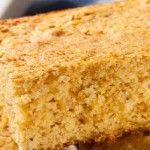
Ingredients
- Black gram flour – 1 cup
- baking powder – 1 tsp
- Sugar – 1/2 cup
- oil/ Ghee – 1/4 cup
- Cocoa powder – 3 tsp
- Egg – 1
Directions
- Beat the egg till it gets frothy.
- Add sugar and beat again. Add oil/ghee mix again.
- Mix black gram flour, cocoa powder as well as baking powder completely and fold with the egg mixture.
- Add the mixture in the glass bowl, lined with butter paper in the microwave oven for 7-8 mins on medium power and after that grill for 3-4 mins.
- The cake is ready.
2. Black Daal
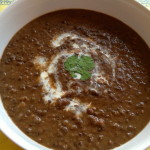
Ingredients
- 3/4 cup black gram dal
- 1/4 cup green gram dal
- 1 large onion finely chopped
- 1 tomato finely chopped
- 1 tsp. ginger garlic paste
- 4 green chillies finely chopped
- 1/4 tsp. turmeric powder
- 1 tsp. lemon juice
- salt to taste
- 3 tbsp. ghee
- 1tsp. chopped coriander
- 1 tsp. each cumin & mustard seeds
- 2 pinches asafoetida
- 1 tsp. sugar
- seasoning:
- 1 bay leaf
- 4 cloves
- 1″ cinnamon stick broken
Directions
- Wash dal and pressure cook in 2 cups water. Cool and remove from cooker.
- Mash very lightly using a spoon.
- Heat half the ghee in the deep saucepan.
- Add seeds, asafoetida, and seasoning. Allow to splutter.
- Add ginger garlic paste, fry for the minute.
- Add onions. Fry till light brown. Add tomatoes and green chillies.
- Fry for 2-3 minutes more.
- Add dal, bring to boil.
- Add turmeric, salt, sugar and lemon juice.
- Take in serving dish.
- Heat remaining ghee in a small saucepan.
- Add chopped coriander to the hot ghee and pour over dal immediately.
- Stir gently. Serve with hot parathas or rice.
3. Black gram laddu
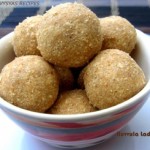
Ingredients
- 1 cup – Black gram (skinned)
- 1 cup – jaggery, grated
- 1/2 cup – Ghee
Directions
- Fry Black Gram.
- When it becomes light brown in colour, cool it and grind it to a fine powder.
- Mix it with grated jaggery.
- Slowly pour hot ghee over this mix and mix well.
- Make laddoos of this mixture.
4. Wheat and Black gram Dosa
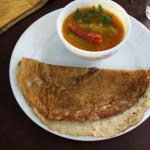
Ingredients
- 1 cup – Black gram
- 2 cups – wheat flour
- 1 tsp – methi seeds
- 1 tbsp – cooked rice
- salt to taste
Directions
- Soak black gram as well as methi together for 3-4 hours.
- Grind it fine along with water while adding the cooked rice.
- Mix it good with wheat flour adding salt.
- Fermant the batter like you always do for dosa by keeping it in the warm place.
- Make dosa the next day. It’s not only low carb. But additionally delicious.
5. Black Gram Puris
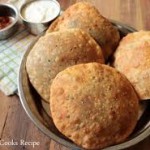
Ingredients
- 250 gms – Black gram
- 250 gms – flour (maida)
- 2 tbsp – hot oil
- 2 to 3 tbsp – oil for frying the dal paste
- enough water
- salt to taste
For Dry Roasting
- 2 – cardamoms (seeds)
- 1 ½ tsp – coriander seeds
- 1 ½ tsp – cumin seeds
- 8 to 10 – pepper corns
- 1 ½ tsp – fennel seeds
- 6 to 8 red dry chilies
- 1 small stick – cinnamon
- 3 to 4 – cloves
Directions
- Clean, wash and soak the urad dal for around 4-6 hours.
- Remove the water and coarsely grind.
- Roast seeds, pepper corns, fennel seeds, and red dry chilies for couple of minutes on the low flame.
- Grind this to powder. Cool.
- Make stiff dough by mixing flour, 2 tbsp of hot oil, salt to taste and enough water.
- Knead the dough well and cover using a cloth and keep aside for around 30 minutes.
- In a kadhai add 2-3 tbsp of oil and fry the dal paste until golden in color on the low flame, stirring continuously.
- Remove from fire and cool completely and now add some masala powder and salt to taste.
- Divide the kept aside dough into 15 equal portions.
- Roll each portion into 3 diameter puree.
- Put a heaped tbsp of the urad dal mixture in the centre of the puree.
- Gather the outer edges of the puree and lightly roll out into small purees.
- Fry the purees in hot oil till golden.
- Serve along with aloo pethe ka sabzi, pickle and onion kachumber.
How to Store
- Sort the urad dal to eliminate stones and any dirt particles.
- It could be saved indefinitely in the airtight container in a cool, dry location.
- Cooked Black gram ought to be kept in the refrigerator and could be useful for up to 3 or 4 days.
Traditional uses
- Roots are used for abscess, ostalgia and inflammations.
- Seed are used to treat anorexia, dyspepsia, constipation, strangury, haemorrhoids, vita, agalactica, neuropathy and hepatopathy.
- Seeds are used on traditional medicine as abscesses.
- Germinated Black gram is helpful for mild diabetics.
- It eliminates toxins from the body and purifies the system.
- It supports digestive health and helpful for diarrhea.
- It serves as an emollient and provides comfy effect on skin.
- Use it as a nervine tonic.
- Take Black gram with honey and gourd juice for 3 to 4 months to cure mild diabetes.
- It is a great supplement for people with malnutrition.
- To treat impotency, take Black gram with honey and wheat bread.
- It is used to heal nervous disorders such as schizophrenia, weakness of memory, hysteria and nervous weakness.
- Apply the paste of Black gram on hair to eliminate dandruffs and cure various hair problems.
- It is used to cure dysentery, gastric catarrh, diarrhea and dyspepsia.
- Black gram helps to heal stiff shoulder, rheumatic pains and contracted knee.
- Externally use the oil extracted from pulse for contracted knee, rheumatism and stiff shoulder.
- To treat headaches due to sinus, roast grey sand, black gram and common salt in a pan. Put it to cloth bag. Smell this bag close to nostrils and continue it for 10 to 15 minutes. Cover the head while and after smelling. It provides relief from blocked nose and headache caused due to sinus.
Precautions
- Excessive consumption of Black gram causes flatulence and accumulation of excessive gas in alimentary canal of human body.
- It could promote uric acid levels in the body so people with gallstones, kidney stones, gout should avoid its consumption.
- Pregnant women who are suffering from constipation should avoid Black gram.
- People who are prone to rheumatic diseases should also avoid it.
How to Eat
- Beans are boiled and consumed whole.
- It is splitted and made into dal.
- In Punjabi cuisine, it is a vital ingredient for making dal makhani.
- In Bengal, it is used to prepare Biulir Dal.
- In Rajasthan, it is used to make dal which is consumed with bati.
- Dosa batter is prepared from rice and split black gram (dehusked) blended with water and fermented overnight.
- Adai is made by mixing black gram, Moong and Channa dal
- In India, Idli is prepared by steaming batter which consists of rice, black gram and fungreek.
- Cook young seedpods and seeds like vegetables.
- Boil the dried seeds and use it in various recipes.
- Make it into paste or ground it into flour.
- Black gram is used for making Dal Makhani.
Other Facts
- Black gram is a crucial pulse crop cultivated in India which is cultivated in about three million hectates.
- About 1.3 million tonnes of Black gram are producted in India.
- It is also used as green manure.
- It is a well-known pulse crop in India, Pakistan, Burma, Bangladesh, Ceylon and Africa.
- In India, Blackgram is grown in Bihar, Andhra Pradesh, Madhya Pradesh, Uttar Pradesh, Maharastra, Punjab, West Bengal, Haryana and Karnataka.
References:
https://www.itis.gov/servlet/SingleRpt/SingleRpt?search_topic=TSN&search_value=506273#null
http://pfaf.org/user/Plant.aspx?LatinName=Vigna+mungo
https://en.wikipedia.org/wiki/Vigna_mungo
http://www.ikisan.in/up-blackgram-history.html
http://www.onlyfoods.net/black-gram.html
http://nutrayou.blogspot.com/2015/10/black-gram-health-benefits.html
https://www.organicfacts.net/health-benefits/other/black-gram.html
https://healthyfocus.org/health-benefits-of-black-gram/
http://vkool.com/benefits-of-black-gram/
Comments
comments


